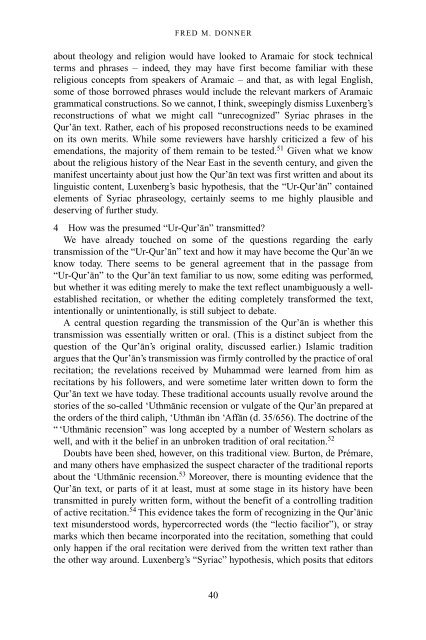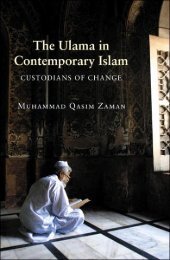The Qur'an in its historical context (pdf - Islam and Christian-Muslim ...
The Qur'an in its historical context (pdf - Islam and Christian-Muslim ...
The Qur'an in its historical context (pdf - Islam and Christian-Muslim ...
Create successful ePaper yourself
Turn your PDF publications into a flip-book with our unique Google optimized e-Paper software.
FRED M. DONNER<br />
about theology <strong>and</strong> religion would have looked to Aramaic for stock technical<br />
terms <strong>and</strong> phrases – <strong>in</strong>deed, they may have first become familiar with these<br />
religious concepts from speakers of Aramaic – <strong>and</strong> that, as with legal English,<br />
some of those borrowed phrases would <strong>in</strong>clude the relevant markers of Aramaic<br />
grammatical constructions. So we cannot, I th<strong>in</strong>k, sweep<strong>in</strong>gly dismiss Luxenberg’s<br />
reconstructions of what we might call “unrecognized” Syriac phrases <strong>in</strong> the<br />
Qur’an text. Rather, each of his proposed reconstructions needs to be exam<strong>in</strong>ed<br />
on <strong>its</strong> own mer<strong>its</strong>. While some reviewers have harshly criticized a few of his<br />
emendations, the majority of them rema<strong>in</strong> to be tested. 51 Given what we know<br />
about the religious history of the Near East <strong>in</strong> the seventh century, <strong>and</strong> given the<br />
manifest uncerta<strong>in</strong>ty about just how the Qur’an text was first written <strong>and</strong> about <strong>its</strong><br />
l<strong>in</strong>guistic content, Luxenberg’s basic hypothesis, that the “Ur-Qur’an” conta<strong>in</strong>ed<br />
elements of Syriac phraseology, certa<strong>in</strong>ly seems to me highly plausible <strong>and</strong><br />
deserv<strong>in</strong>g of further study.<br />
4 How was the presumed “Ur-Qur’an” transmitted?<br />
We have already touched on some of the questions regard<strong>in</strong>g the early<br />
transmission of the “Ur-Qur’an” text <strong>and</strong> how it may have become the Qur’an we<br />
know today. <strong>The</strong>re seems to be general agreement that <strong>in</strong> the passage from<br />
“Ur-Qur’an” to the Qur’an text familiar to us now, some edit<strong>in</strong>g was performed,<br />
but whether it was edit<strong>in</strong>g merely to make the text reflect unambiguously a wellestablished<br />
recitation, or whether the edit<strong>in</strong>g completely transformed the text,<br />
<strong>in</strong>tentionally or un<strong>in</strong>tentionally, is still subject to debate.<br />
A central question regard<strong>in</strong>g the transmission of the Qur’an is whether this<br />
transmission was essentially written or oral. (This is a dist<strong>in</strong>ct subject from the<br />
question of the Qur’an’s orig<strong>in</strong>al orality, discussed earlier.) <strong>Islam</strong>ic tradition<br />
argues that the Qur’an’s transmission was firmly controlled by the practice of oral<br />
recitation; the revelations received by Muhammad were learned from him as<br />
recitations by his followers, <strong>and</strong> were sometime later written down to form the<br />
Qur’an text we have today. <strong>The</strong>se traditional accounts usually revolve around the<br />
stories of the so-called ‘Uthmanic recension or vulgate of the Qur’an prepared at<br />
the orders of the third caliph, ‘Uthman ibn ‘Affan (d. 35/656). <strong>The</strong> doctr<strong>in</strong>e of the<br />
“ ‘Uthmanic recension” was long accepted by a number of Western scholars as<br />
well, <strong>and</strong> with it the belief <strong>in</strong> an unbroken tradition of oral recitation. 52<br />
Doubts have been shed, however, on this traditional view. Burton, de Prémare,<br />
<strong>and</strong> many others have emphasized the suspect character of the traditional reports<br />
about the ‘Uthmanic recension. 53 Moreover, there is mount<strong>in</strong>g evidence that the<br />
Qur’an text, or parts of it at least, must at some stage <strong>in</strong> <strong>its</strong> history have been<br />
transmitted <strong>in</strong> purely written form, without the benefit of a controll<strong>in</strong>g tradition<br />
of active recitation. 54 This evidence takes the form of recogniz<strong>in</strong>g <strong>in</strong> the Qur’anic<br />
text misunderstood words, hypercorrected words (the “lectio facilior”), or stray<br />
marks which then became <strong>in</strong>corporated <strong>in</strong>to the recitation, someth<strong>in</strong>g that could<br />
only happen if the oral recitation were derived from the written text rather than<br />
the other way around. Luxenberg’s “Syriac” hypothesis, which pos<strong>its</strong> that editors<br />
40



